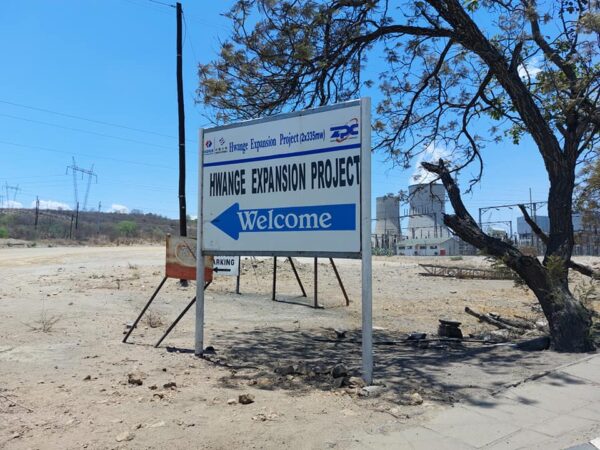The Association of Mine Managers of Zimbabwe (AMMZ) yesterday was on a technical visit at the Zimbabwe Power Company (ZPC) to learn more about the power generation at the newly installed units 7 and 8 of the Hwange expansion project.
The team was briefed on how power is generated at the Power plant by the Acting Facility Site Manager Lucia Chibanda said her team is responsible for units 7 and 8 which have an installed capacity of 670 megawatts. The team also toured the Mega facility which is much bigger than any current operating mine in Zimbabwe.
Briefing the AMMZ members Chibanda said, to support power generation, the project includes a water pipeline spanning 42 kilometres from Deka and a new reservoir with a capacity of 250,000 cubic meters. The water is treated using reverse osmosis, ultrafiltration, and demineralization processes to ensure it is pure and free from minerals that could cause scaling in the boiler tubes. The treated water is then heated in the boiler using coal as the fuel source. The steam generated from the heated water rotates the turbine, which in turn produces electricity through generators with magnetic fields.
“In terms of power generation. Our key input is water, which comes from Deka. We built a new reservoir up there. It has a capacity of 250,000 cubic meters to hold water. That’s for approximately six, five, five days. So it is pumped to our reservoirs. From the reservoirs, we’ve got underground pipelines that we installed. We go to the raw water. Basically, raw water is treated. We’re just adding chlorine. It will be now safe to drink.
“We bring it to this building that is just behind you. We call it the chemical water treatment plant. There, we have three different types of treatments. We’ve got reverse osmosis. We’ve got ultrafiltration. Then we’ve got demineralization. What we are simply trying to do is remove all the minerals in the water to make it as pure as possible. We actually make it more pure than the bottled water that we drink, so that we avoid scaling in our boiler tubes.
“From here, the water is pumped to the boiler. We’ve got various auxiliaries that you see when you go through the plant, mainly on the ground floor. These are boiler feed pumps, condensate pumps, cooling water pumps, etc. Our water goes to the boiler. That’s where it’s heated to temperatures of 541. We increase pressure to about 167 bars. That’s almost 80 times the pressure in your vehicle tires.
“Then we have superheated steam. Our turbines use superheated steam, different from Kariba, which uses water. That’s why that water that is stored in the dam, you get the issues of water levels. Here, we use steam, which is generated from water that is heated. But for us to be able to heat the water in the tubes, we need coal. That’s our fuel source. So we have coal that comes from the coal miners. We have a coal stockyard. It’s conveyed through the conveyance system, which are basically belts. Then we have a bank, how we can store it.
“It goes to the mills. I’m sure those who come from the mines will appreciate how a mill works. We grind the coal to fine powder. It’s pushed by air, which is sucked through our fan or draft system. We’ve got big fans, the forced draft fan and the induced draft fan. The air pushes the fine powder, the coal, and it ignites. We have a fireball inside our boiler. You won’t be able to see it on the boiler. The tubes are all encased inside, and they’re insulated,” Chibanda explained.
Once the steam has done its work, it is cooled back into water using cold water from the reservoir. The cooling process takes place in a cooling tower, allowing the water to be reused in the closed cycle of power generation.
“Hot water becomes steam. Superheated steam goes to the turbine. On the turbine, what we basically want is mechanical energy. We want to rotate the turbine. Once the turbine is rotating and we have magnetic fields, that’s how we produce electricity. This is done by the generator.
“There’s a magnetic field that is in the generator and when the shaft, which is coupled to the turbine, rotor is rotating, we produce electricity. Then we have got transformers. Those ones will be outside the plant. You want to step up, would have generated electricity at 20 kVA. But when we transmit it, we need to transmit it at a higher voltage. That’s the 400 and the 330. So we then use the different transformers that we have to step it up.
“Then in terms of the steam. The steam that has done work, it’s a closed cycle, based on the Rankine cycle or the thermal cycle. We want to use that water again. So we cool the steam back to water. We use cold water, which is from the raw water reservoir. We cool the steam. It becomes water again. That water which has cooled the steam, we take it to the cooling tower, which is, I think, the most popular shape for anything. The one with the Venturi shape that you see is the one where water is cooled, and it becomes cold again. And then you see water vapour escaping from the top of the cooling tower. I would say in a nutshell, that’s the basic process of how we generate electricity,” Chibanda concluded.
The AMMZ is currently on day two of its AGM and conference. The first day saw Zimplats’ Ngwarati Mine winning the AMMZ SHE Audits scoring 97% ahead of Mupfuti’s 94%.
Both Ngwarati and Mupfuti reported zero fatalities, zero Total Recordable Injury Frequency Rate, zero Lost Time Injury Frequency Rate, and zero Lost Time Injury Severity Rate.
.png)




